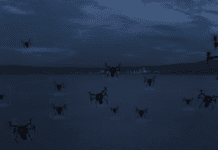This post is also available in:
 עברית (Hebrew)
עברית (Hebrew)
In response to the escalating drone warfare in the Russia-Ukraine conflict, Ukraine has introduced an interesting electronic warfare system designed to identify and neutralize enemy drone operators. Named Aero Azimuth, this innovative system utilizes large balloons to carry its sophisticated sensors, significantly enhancing Ukraine’s capabilities in the ongoing battle against drone threats.
The Aero Azimuth system, developed by the Ukrainian company Kvertus, employs an aerostat created by Aero Bavovna to maintain its airborne position. Displayed at the “Protect Warrior from Drone” event and reported by the Ukrainian defense portal Militarnyi, the system represents a novel approach to electronic warfare. Unlike traditional methods that focus on neutralizing individual drones or swarms, Aero Azimuth targets the root of the drone threat by identifying and locating the operators controlling these UAVs.
According to Interesting Engineering, the primary function of Aero Azimuth is to detect the location from which enemy drone operators are directing their UAVs. By pinpointing these control centers, Ukrainian forces can carry out targeted strikes to disrupt or eliminate the threat posed by enemy drones. This method aims to address the problem at its source, potentially providing a long-term solution by neutralizing not just the drones but also their operators and supporting infrastructure.
According to the company, the Aero Azimuth system operates by detecting UAVs by tracking the signals of their onboard systems, including control, telemetry, and data transmission channels. It boasts a maximum detection range of 30 kilometers and can simultaneously track multiple targets. Weighing just 8 kilograms, the system is designed for prolonged airborne operations, making it highly effective for extended surveillance missions.
According to reports, the Aero Azimuth units will be deployed on Aero Bavovna’s aerostats positioned 9 kilometers from Russian contact points at varying altitudes to optimize detection while ensuring protection from enemy drones and fire. Despite this positioning slightly reducing the detection range, it enhances the system’s survivability. When airborne at average flight altitudes, the Aero Azimuth was able to detect radio sources communicating with drones at a distance of 60 kilometers.
The ongoing Russia-Ukraine war has seen extensive use of drones for various military purposes, including attacks on tanks, military bases, and infrastructure. In response, anti-drone systems like Aero Azimuth are becoming crucial in countering these threats.

























